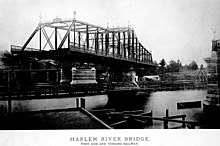Putnam Bridge (New York City)
| Putnam Bridge | |
|---|---|
 |
|
| Coordinates | 40°49′55.75″N 73°56′3.56″W / 40.8321528°N 73.9343222°WCoordinates: 40°49′55.75″N 73°56′3.56″W / 40.8321528°N 73.9343222°W |
| Carries | Putnam Division (1881-1918), 9th Avenue El (1918-1940), Polo Grounds Shuttle (1940-1958) |
| Crosses | Harlem River |
| Locale | Manhattan and the Bronx, in New York City |
| Characteristics | |
| Design | Swing bridge |
| Total length | 1,004.4 feet (306.1 m) |
| Width | 40 feet (12.19 m) including walkways |
| Longest span | 297 ft 8 3⁄8 in (90.74 m) |
| Clearance below | 28 feet (8.53 m) |
| History | |
| Opened | May 1, 1881 |
| Closed | August 31, 1958 |
Putnam Bridge was a swing bridge that spanned the Harlem River and the adjacent tracks of the New York, New Haven & Hartford Railroad in New York City, connecting the boroughs of Manhattan and the Bronx near the current location of Yankee Stadium. It carried two tracks of the New York & Putnam Railroad, and later the 9th Avenue elevated line of the IRT, as well as two pedestrian walkways outside the superstructure.
The bridge opened to rail and pedestrian traffic on May 1, 1881. As with the other Harlem River swing bridges, the bridge was designed by Chief Engineer Alfred Pancoast Boller; the contractors were Clarke, Reeves & Co., and Smith, Ripley & Co. The bridge's total length was 1,004.4 feet (306.1 m), comprising a main span of 300 feet (91 m) (the largest double-track draw span in the world at the time of construction), two identical deck truss side spans of 100 feet (30 m) each, and four approach spans on either side. When closed, the bridge provided 28 feet (8.5 m) of vertical clearance, and when opened, two shipping channels of 124 feet (38 m) and 123 feet (37 m) in the east and west channels respectively.
The Putnam Bridge was built by the New York City & Northern Railroad, a predecessor of the NY&P, and operated by its subsidiary, the West Side & Yonkers Railway (not to be confused with the West Side and Yonkers Patent Railway, the original operator of the 9th Avenue line). The location for the bridge was formally approved by the Board of Parks Commissioners on January 7, 1880. Construction was authorized by the Board of Rapid Transit Commissioners on February 18, 1880, was underway by April of that year, and completed April 28, 1881; train service began running on the following Sunday, May 1, 1881. The construction was marred by an accident on November 26, 1880, when a truss that was being moved into position flipped over unexpectedly, knocked a second truss loose, and caused both to fall through the scaffolding, killing one laborer and injuring four others, but otherwise proceeded without notable incident.
...
Wikipedia
